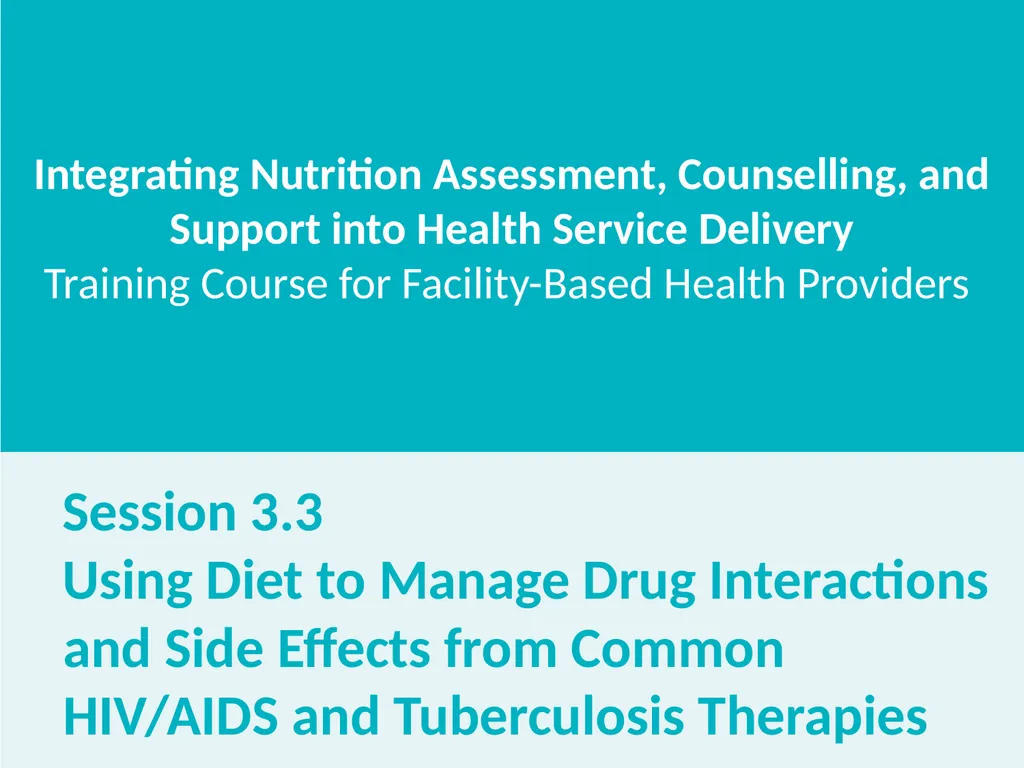Integrating Nutrition Assessment, Counselling, and
Author : conchita-marotz | Published Date : 2025-05-13
Description: Integrating Nutrition Assessment Counselling and Support into Health Service Delivery Training Course for FacilityBased Health Providers Session 33 Using Diet to Manage Drug Interactions and Side Effects from Common HIVAIDS and
Presentation Embed Code
Download Presentation
Download
Presentation The PPT/PDF document
"Integrating Nutrition Assessment, Counselling, and" is the property of its rightful owner.
Permission is granted to download and print the materials on this website for personal, non-commercial use only,
and to display it on your personal computer provided you do not modify the materials and that you retain all
copyright notices contained in the materials. By downloading content from our website, you accept the terms of
this agreement.
Transcript:Integrating Nutrition Assessment, Counselling, and:
Integrating Nutrition Assessment, Counselling, and Support into Health Service Delivery Training Course for Facility-Based Health Providers Session 3.3 Using Diet to Manage Drug Interactions and Side Effects from Common HIV/AIDS and Tuberculosis Therapies Session Objectives By the end of the session, participants will be able to: Identify common therapies used by people living with HIV and TB Discuss drug-food interactions and side effects related to HIV and TB therapies Discuss drug-food interactions and side effects related to complementary and alternative medicines (CAM) Introduction PLHIV take medications to Treat HIV (slowing progress) Treat and reduce opportunistic infections Reduce and ease symptoms Treat other diseases/conditions Antiretroviral therapy (ART) Simpler to administer than in previous years More accessible than before Potential to improve nutrition Drugs taken by PLHIV can: Interact with certain foods and nutrients, affecting the drugs’ efficacy and clients’ adherence to the drugs Create side effects that affect food intake and nutrient absorption and can also reduce adherence to medications Can lead to weight loss and undernutrition Service providers need to understand the food and nutrition implications and side effects of the drugs clients are taking and identify/implement appropriate responses. Introduction Note on Special Populations Service providers should be particularly attentive to: Undernourished clients initiating treatment Increased risk of death so they need close monitoring Food insecurity can prevent PLHIV from following food and nutrition recommendations. Help clients identify feasible alternative responses and when possible seek options to improve food security. Pregnant/lactating women with HIV Have increased nutrition needs Manage drug and food interactions promptly to protect health of mother and infant Common Therapies Used by PLHIV What are some common therapies (modern or traditional) used by people living with HIV in Uganda? PLHIV may use both traditional and modern therapies to treat HIV and opportunistic infections (OIs) and alleviate symptoms. Modern therapies ARVs slow progression of HIV into disease Main types of ARVs used in sub-Saharan Africa: Non-nucleoside reverse transcriptase inhibitors (NNRTI) Nucleoside/ nucleotide analogue reverse transcriptase inhibitors (NRTI) Protease inhibitors (PI) Multiple ARVs are combined to enhance efficacy = HAART (highly active antiretroviral therapy) Common Therapies Used by PLHIV Other types of drugs taken by PLHIV include: Antifungal drugs (e.g., Nystatin, Nizoral, and fluconazole) TB therapy (e.g., Rifampin) Antibiotic (Cotrimoxazole) as prophylaxis against PCP Antimalarial drugs (e.g., Coartem, quinine) Antihelminthic drugs (e.g., mebendazole, albendazole) to treat intestinal parasites and worms Common Therapies Used by PLHIV Traditional therapies: to alleviate














